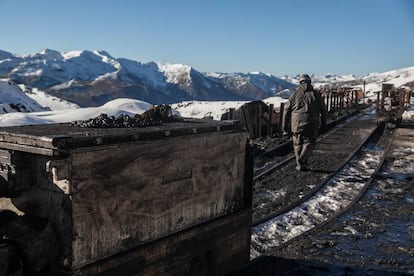Greenhouse gas emissions drop in Spain as power plants ditch coal
Energy produced at coal-fired thermal stations made up less than 5% of all electricity generated in 2019, as natural gas and renewables become more profitable options


Spain has taken just one year to reach a goal that was expected to require a decade. The government had predicted that by 2030 coal would no longer be used in power plants to generate electricity, yet this objective was all but achieved last year. The country has dramatically reduced its reliance on coal-fired power, and as a direct result, carbon dioxide (CO2) emissions from electricity generation fell 33.3% in 2019, according to figures that Red El¨¦ctrica de Espa?a (REE), the national power grid operator, advanced to EL PA?S.
For decades, coal-powered thermal plants have been one of the main sources of electricity. But in 2019 Spain turned its back on this fossil fuel, which when burned releases carbon dioxide ¨C a primary greenhouse gas that contributes to global warming.
Coal-fired thermal plants generated under 5% of total electricity, or 85.6% less than in 2002
Coal mining in Spain came to an end on January 1, 2019, when Spain stopped providing state aid to its flailing coal mines in observance of European Union regulations and due to the poor profitability of national coal deposits. But it was expected that Spanish thermal plans that use imported coal ¨C those which are located along the coast and have coal shipped in ¨C would continue operating for some years to come. Indeed, the owners of these mines had invested millions of euros in adapting to the new EU standards on polluting emissions that came into effect this year.
But coal-fired electricity dropped dramatically in 2019 to its lowest point since REE began keeping records in 1990. Last year coal-powered thermal plants contributed less than 5% of all electricity generated in Spain ¨C 85.6% less than in 2002, when coal power was at its peak. What¡¯s more, there were five days (December 14, 21, 22, 24 and 25) when Spain did not need any coal-powered electricity at all.
There are many reasons why it is no longer financially profitable for electricity companies to maintain thermal plants. According to the expert group Carbon Tracker, the owners of these Spanish plants were expected to lose €992 million by the end of 2019. One of the main reasons is the EU emissions trading system, the world¡¯s first major carbon market. After nearly 15 years, the EU agreed to set a price for releasing carbon dioxide that was high enough to discourage the use of this fossil fuel. During 2019, the price of a ton of CO2 was €25, meaning that in many European countries coal-fired electricity is not as profitable as other options like natural gas or renewable energy.
Last year 36.8% of the country¡¯s electricity came from renewable energy sources
The EU emissions trading scheme has turned out to be a useful instrument in the fight against climate change in Europe. The problem is that there is still no agreement on a global system, which became apparent at the United Nations climate summit held in Madrid in December.
The drop in the cost of natural gas and the introduction of renewable energy have also contributed to the fall in coal-powered electricity. Green energy installations jumped by 10% in 2019. According to REE, 36.8% of the country¡¯s electricity came from renewable energy sources, and 58.6% was free of carbon dioxide emissions (from both renewable and nuclear power).
Thanks to these factors, the Spanish power sector ended 2019 having released just over 43 million tons of carbon dioxide ¨C 33.3% less than the 64.5 million tons released into the atmosphere in 2018.
The power sector accounts for 17% of the Spanish economy¡¯s carbon dioxide emissions. The fall in coal-powered plants is expected to be reflected in a global fall in carbon dioxide emissions for 2019. But last year¡¯s figures on the transportation sector (namely cars and trucks), which contributed 27% of greenhouse gases in 2018, and industry, which contributed 19%, have yet to be released. In recent years, the drop in power plant emissions has been compensated by the rise in transportation emissions.
English version by Melissa Kitson.
Tu suscripci¨®n se est¨¢ usando en otro dispositivo
?Quieres a?adir otro usuario a tu suscripci¨®n?
Si contin¨²as leyendo en este dispositivo, no se podr¨¢ leer en el otro.
FlechaTu suscripci¨®n se est¨¢ usando en otro dispositivo y solo puedes acceder a EL PA?S desde un dispositivo a la vez.
Si quieres compartir tu cuenta, cambia tu suscripci¨®n a la modalidad Premium, as¨ª podr¨¢s a?adir otro usuario. Cada uno acceder¨¢ con su propia cuenta de email, lo que os permitir¨¢ personalizar vuestra experiencia en EL PA?S.
En el caso de no saber qui¨¦n est¨¢ usando tu cuenta, te recomendamos cambiar tu contrase?a aqu¨ª.
Si decides continuar compartiendo tu cuenta, este mensaje se mostrar¨¢ en tu dispositivo y en el de la otra persona que est¨¢ usando tu cuenta de forma indefinida, afectando a tu experiencia de lectura. Puedes consultar aqu¨ª los t¨¦rminos y condiciones de la suscripci¨®n digital.










































